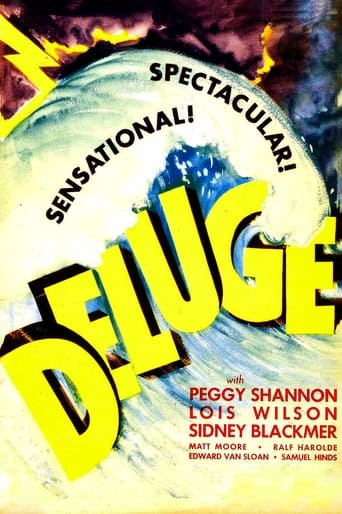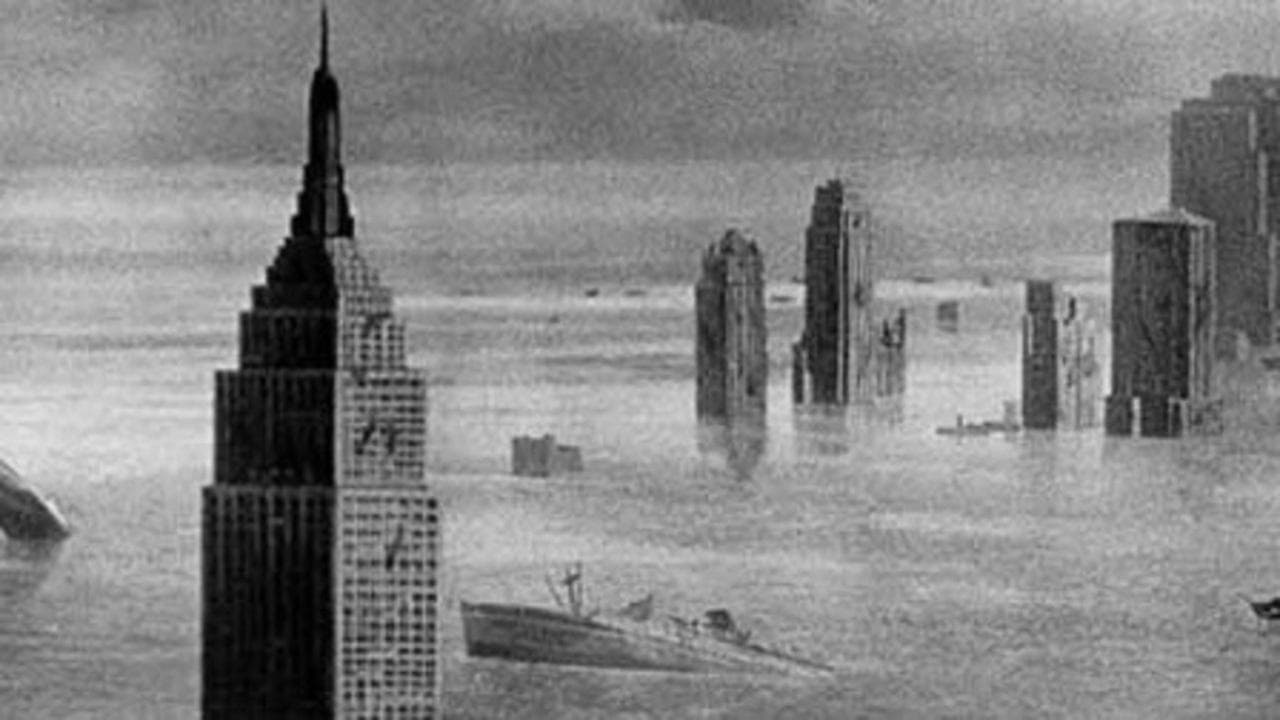gavin6942
A massive earthquake strikes the United States, which destroys the West Coast and unleashes a massive flood that threatens to destroy the East Coast as well.S. Fowler Wright, the author of the novel upon which the film was based, began pitching a script based on the book to studios in 1933. He accepted an offer from Worldwide Studios for $5,000 for the options. An independent, Admiral Productions, produced the film with a budget of $171,000. Wright later watched the final scenes being shot and was disappointed to learn that producers had made changes and chose to not use the ending of the book as the film's ending. He later wrote in his diary that he felt the film was "ghastly" and advised his children not to see it.Not being familiar with the book, I could not say what changes were made and what would make the film version "ghastly". It is, however, rather boring. For a film about a world-destroying flood, most of the short run time is about a group of men sitting around chatting, planning on how to get women to marry them. I suppose there is historic value to the film and I am glad it has gone from "lost" to restored, but it may have had a better reputation lost than actually viewed.
danm99
For a long time, I had read bits about this very strange early 'talkie film', and it did arouse my artistic curiosity. There was constant mention of DELUGE being another one of those "forever lost films", but a copy did (no pun intended) surface, and I finally was able to see this very early and interesting cinematic end-of the-world rarity.The suspenseful beginning is genuinely scary, in spite of its preposterous science: Puzzled scientists discover that the world's weather is going through some pretty weird changes - and that a menacing global storm is brewing on the horizon. The writing and sincere acting makes it all seem quite credible and possible. But that's not all: Major earthquakes and massive floodings begin to mysteriously occur (Did a very young Irwin Allen ever see this?) - and the ocean levels start rising rapidly. (Was this an allegorical profecy of Global Warming?). I very much liked the "flaw"; being that no pseudo-scientific explanation for the disaster is offered. It adds that bizarre 'twilight zone' touch, where suspension of disbelief can drive you to questioning your own beliefs.The whole world is thrown into a state-of-alarm as all air flights are grounded and shipping is haulted (Almost an eerie foreshadowing of 9/11). Then continents begin to sink into the ocean (though we only hear about it from chilling urgent news bulletins, which seems to ominously predate the 'This is only a Test' nuclear/scare broadcasts that began in the bleak paranoid 'McCarthy-Era' fifties).The character focus then switches to an "average" married couple (Is there really such an animal?) as they flee to a grotto (confused as to why they'd go there to seek hopeful safety, but then this is a movie, where character, theme and riveting plot are the keynotes. Common sense can go to hell. Movies weren't really doing much different then than they are now). The radio broadcasts (this was way before the invention of that notorious tube) grimly instruct NYC residents to quickly evacuate as the overwhelming meteorlogical horrors approach. (As the film's logo states - EARTH IS DOOMED!).Then comes the crucial scene that DELUGE earned its niches of historical film fame for - the tremendous earthquake capped by a gigantic tidal wave, that catastrophically destroys and buries New York under the vast ocean that has now blanketed most of the Earth. (Nothing like double-standards, isn't there?). Naturally, the simple yet oddly spectacular FX are dated, but nonetheless, I found them to be quite shuddery, and was able to suspend any trifling disbelief. Seeing NYC crumble as the earth rips open, with the almighty ocean pouring in, is quite scary on its own offbeat terms. (Can anyone pronounce "DEEP IMPACT" & "ARMEGEDDON"?). Back then, filmmakers were forced to rely on creative ingenuity and they utilized much imaginative resourcefulness and personal intimate touches which skillfully brought the nightmares up close and deeply personal. Any Questions?My only main complaint is that all this harrowing mayhem occurs within the first twenty minutes. I dig plots that immediately engage and moooooove, but this was stretching that storytelling ethic a bit too much. You could have easily (with tons of backbreaking and nerve-frazzling work) produced the entire film about the disasterous build-ups to THE END.
Obviously, that would have required a high-budget and expensive FX that were still in their infant but inspired level - but what a terrifying science-fiction horror thriller it could have been! I honestly have doubts that todays upgraded technical FX would have that personal creepiness that this admirable effort fearfully evokes in its dark foreboding ways. Also, the "updated" script would undoubtably be crammed with stupid cliched dialogue and one-dimensional sterotyped characters you couldn't care less about.Later, Republic Studios purchased DELUGE for that ruthless purpose of using the destruction scene for seriel and B-movie stock footage; which hence accounts for the film' "loss". They most likely threw the rest of the footage into the can, clever boys.Unfortunately, the rest of the story is about the fate of a handful of survivors, struggling to live-as-best on a small portion of land that was spared the great plunge. We have a gang of violent renegades out to make hell for the heros (That's what heros are there for), as well as raping and murdering the women, which happens offscreen, making its repelling inferences that much more ugly. This was still brutally daring for the early 3O's, but this was also back in that so-called pre-code era.
Most impressive character was the gorgeous swimmer played by the equally gorgeous Peggy Shannon, who, sad to say, died untimely a few years later from acute alcoholism. Her atypical (especially for the time) character might interest feminists, for she excellently portrays an attractive young adventuresome woman who is also tough enough to hold her own - quite ahead of the time. (Can anyone say Anne Heche?).WARNING: POSSIBLE SPOILER. The conclusion, though, was not that usual formulaic happy ending, obviously made to make you think - and that can be quite disturbing sometimes. I urge, particularily film historians or anyone interested in Hollywood's very first end-of-the-world movie, to give this strange early science-fiction effort a wild, reverent look.
Mike Cloud
I read about this movie years ago but thinking that no prints existed, only recently looked for a rental copy. It was much better than reviews lead me to believe. The destruction of New York City was quite convincing especially when the earth opened up and the ocean rushed in. The screenwriters were smart not to offer any explanation for the disaster. Perhaps this was due to time and budget constraints. The scientists' bewilderment added to the tension.The survivors' story was credible even though the lead characters were somewhat stupid. Martin and Claire spent the night in a tunnel knowing full well that armed men were coming for them at first light. They could have easily escaped during the night.The story had several gaps probably due to lost or deteriorated film. How did Martin become separated from his wife and children? Why did each think the other was dead? The Statue of Liberty was still standing at the end of the storm sequence. Did it survive?The Italian dialog was distracting and the English subtitles did not convey everything that was spoken. There was something said about Louisiana sinking and New Orleans being flooded. When survivors in the settlement cannot raise anything on the radio, a boy says to an adult, "Now you can be the fire chief". I'm going out on a limb and say the boy is referring to comedian Ed Wynn who portrayed the Texaco Fire Chief on an early radio program. This must have been very confusing to foreign audiences.The actress who played Claire, Peggy Shannon, was strikingly beautiful with a modern look not normally seen in movies of that period. How sad that she died of alcoholism just 8 years after the movie was released.
danr51
Back at the start of the "talkies", in 1933, RKO Studios produced this compelling vision of the Earth destroyed by natural disasters. Until recently, this was a lost film, all prints of it presumed gone. I managed to obtain a VHS copy of this, essentially, low budget production directed by Felix Feist. For cinema historians, this is highly recommended viewing; just don't expect CGI perfection, for we're talking decades before our glorious computers were invented.The first twenty minutes are the most terrifying I can recall. For apparently no rhyme or reason, scientists discover that the Earth's weather has drastically changed: The barometers are dropping rapidly, the wind velocity is increasing, and a mysterious, unscheduled solar eclipse has occurred. Unlike most science-films, no pseudo-scientific explanations are offered. the world's officials and citizens are thoroughly baffled and horrified. To worsen the disturbing mystery, Earthquakes and tidal waves then break out, destroying and sinking most of the land on our planet, leaving the world a vast ocean with millions dead.The spectacular sequence of the destruction of New York is spellbinding and memorable. Though the effects are naturally dated, they are nevertheless convincing and frightening. Buildings crumble, people perish and a tremendous flood buries the world's largest city (though some may not consider that to be any great tragedy). The sense of doom and dread convey an overpowering deluge. The film's title conveys a double meaning; a gigantic flood and a state of being overwhelmed. As the tag line reads, EARTH IS DOOMED! And that's no phoney promo, DELUGE lives up to its hype. A one of a kind effort and an early experiment in special-effects.The story's opening is directed in an eerir Twilight Zone manner. Believable dialogue and an astute lack of sopomoric jargon enhance its credibility and effectiveness. A totally impossible nightmare plagues the human race, and no one knows how or why. Obviously, no solution to the bizzare occurance prevails. Reality and illusion converge with catastrophic results. Its grim, somber tone is undeniable and unrelenting. They don't make paranoia like they used to.However, the film's main drawback is that once the devastation is over, the excruciating tension diminishes and we're left with a standard tale of a group of survivors marooned on a strip of land that still remains above water, a few miles away from where New York once was. Though not bad (remember it was still the first of its kind), it still pales considerably compared to the powerful and unforgettable opening.If DELUGE had concentrated solely on the catastrophie, and the suspenseful events leading up to it, it could have been a great classic. As it is, it's still quite a unique effort (considering its low budget) and an interesting curio. Perhaps Irwin Allen saw this back in his childhood.Check this out, but don't expect an Industrial Light and Magic enterprise and Harrison Ford. We're talking nearly seventy years ago. It was 'Famous Monster's' Forrest J. Ackerman who uncovered the only known existing print (way back in the eighties) dubbed in Italian and sub-titled, giving it a foreign film cinema verite appearence. Very honorable deed, Forrey, but why did you wait so long to tell us?


 AD
AD


